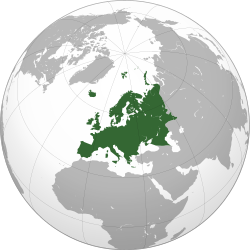Europe
 | |
| Area | 10,180,000 km2(3,930,000 sq mi)[n] |
|---|---|
| Population | 739,165,030[n] (2011), 3rd) |
| Pop. density | 72.5/km2 |
| Countries | 50 (list of countries) |
| Languages | List of languages |
| Time zones | UTC to UTC+6 |
Main articles: Europe and List of sovereign states and dependent territories in Europe
Further information: Geography of Europe
For a table of sovereign states and dependent territories in Europe with geographical data such as area, population, and population density, see here.
Europe ( i/ˈjʊərəp/ ewr-əp or /ˈjɜrəp/ yur-əp[13]) is, by convention, one of the world's seven continents. Comprising the westernmost peninsula of Eurasia, Europe is generally divided from Asia by the watershed divides of the Ural andCaucasus Mountains, the Ural River, the Caspian and Black Seas, and thewaterways connecting the Black and Aegean Seas.[14] Europe is bordered by the Arctic Ocean to the north, the Atlantic Ocean to the west, theMediterranean Sea to the south, and the Black Sea and connected waterways to the southeast. Yet the borders of Europe—a concept dating back toclassical antiquity—are somewhat arbitrary, as the primarily physiographicterm "continent" can incorporate cultural and political elements.
i/ˈjʊərəp/ ewr-əp or /ˈjɜrəp/ yur-əp[13]) is, by convention, one of the world's seven continents. Comprising the westernmost peninsula of Eurasia, Europe is generally divided from Asia by the watershed divides of the Ural andCaucasus Mountains, the Ural River, the Caspian and Black Seas, and thewaterways connecting the Black and Aegean Seas.[14] Europe is bordered by the Arctic Ocean to the north, the Atlantic Ocean to the west, theMediterranean Sea to the south, and the Black Sea and connected waterways to the southeast. Yet the borders of Europe—a concept dating back toclassical antiquity—are somewhat arbitrary, as the primarily physiographicterm "continent" can incorporate cultural and political elements.
Europe is the world's second-smallest continent by surface area, covering about 10,180,000 square kilometres (3,930,000 sq mi) or 2% of the Earth's surface and about 6.8% of its land area. Of Europe's approximately 50 states,Russia is by far the largest by both area and population, taking up 40% of the continent (although the country has territory in both Europe and Asia), while the Vatican City is the smallest. Europe is the third-most populous continent after Asia and Africa, with a population of 733 million or about 11% of the world's population.[15]
Europe, in particular Ancient Greece, is the birthplace of Western culture.[16] It played a predominant role in global affairs from the 15th century onwards, especially after the beginning of colonialism. Between the 16th and 20th centuries, European nations controlled at various times the Americas, most of Africa, Oceania, and large portions of Asia. In 1900, Europe's share of the world's population was 25%.[17] Both World Wars were largely focused upon Europe, greatly contributing to a decline in Western European dominance in world affairs by the mid-20th century as the United States andSoviet Union took prominence.[18] During the Cold War, Europe was divided along the Iron Curtain between NATO in the west and the Warsaw Pact in the east. European integration led to the formation of the Council of Europe and the European Union in Western Europe, both of which have been expanding eastward since the revolutions of 1989 and the fall of the Soviet Union in 1991.
No comments:
Post a Comment